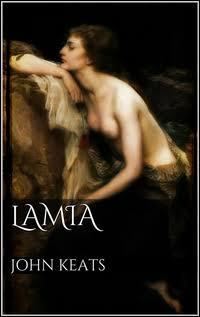Originally published 1820 | ||
 | ||
Similar John Keats books, Other books | ||
Lamia is a narrative poem written by English poet John Keats which was published in 1820.
Contents
The poem was written in 1819, soon after "La belle dame sans merci" and his odes on Melancholy, on Indolence, to a Grecian Urn and to a Nightingale and just before "Ode to Autumn". The poem tells how the god Hermes hears of a nymph who is more beautiful than all. Hermes, searching for the nymph, instead comes across a Lamia, trapped in the form of a serpent. She reveals the previously invisible nymph to him and in return he restores her human form. She goes to seek a youth of Corinth, Lycius, while Hermes and his nymph depart together into the woods. The relationship between Lycius and Lamia, however, is destroyed when the sage Apollonius reveals Lamia's true identity at their wedding feast, whereupon she seemingly disappears and Lycius dies of grief.
Influence on Poe
Keats's poem had a deep influence on Edgar Allan Poe's sonnet "To Science", specifically lines 229–238 and the discussion of the baleful effects of "cold philosophy":
Poe's closing lines also echo several lines near the middle of "Lamia". The book Unweaving the Rainbow by Richard Dawkins takes its title from the above-quoted passage: it is an explicit attempt to demonstrate that this view of "cold philosophy" is incorrect and that science reveals, rather than destroys, the true beauty of the natural world. The poem also influenced Edward MacDowell's symphonic poem, Lamia, Opus 29.
Productions
The poem was dramatized on BBC Radio 4 on 1 January 2010 on the Afternoon Play series (later re-broadcast on 5 January 2012). The production was directed by Susan Roberts with original music composed and performed by John Harle. The cast included:
